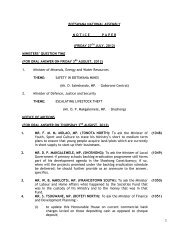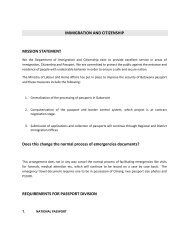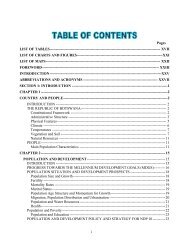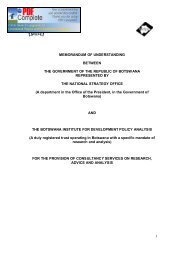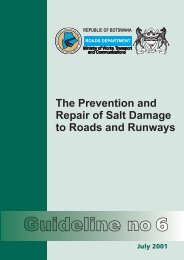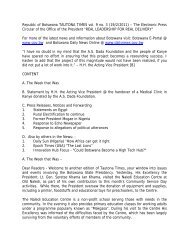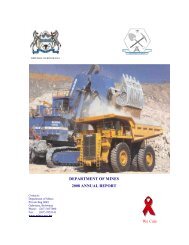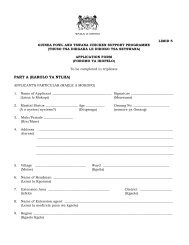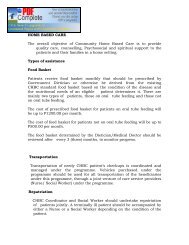National Nutrition and HIV/AIDS Guidelines for Service Providers of ...
National Nutrition and HIV/AIDS Guidelines for Service Providers of ...
National Nutrition and HIV/AIDS Guidelines for Service Providers of ...
Create successful ePaper yourself
Turn your PDF publications into a flip-book with our unique Google optimized e-Paper software.
CHAPTER 9<br />
PLWHA may take various types <strong>of</strong> medications to reduce the effects <strong>of</strong> <strong>HIV</strong> on the body, to treat<br />
opportunistic infections, <strong>and</strong> other common ailments such as colds, malaria, <strong>and</strong>/or intestinal<br />
parasites. Some also use herbal remedies <strong>and</strong> take micronutrient supplements. Though there is no<br />
cure yet <strong>for</strong> <strong>HIV</strong>/<strong>AIDS</strong>, antiretroviral (ARV's) drugs are being used to manage <strong>HIV</strong> by lowering the<br />
viral load <strong>and</strong> thus reducing morbidity <strong>and</strong> mortality.<br />
Effective medical treatment can slow the progression <strong>of</strong> <strong>HIV</strong>, reduce opportunistic infections, <strong>and</strong><br />
ease symptoms, but food can interact with drugs <strong>and</strong> affect the drugs' efficacy. Drugs can also<br />
interact with foods <strong>and</strong> nutrients <strong>and</strong> negatively affect nutritional status. The side effects <strong>of</strong> both<br />
traditional <strong>and</strong> modern medications can affect both food intake <strong>and</strong> nutrient absorption <strong>and</strong><br />
thereby the client's adherence to medications. Additionally, drugs <strong>and</strong> food can interact to cause<br />
adverse effects. Ultimately, if not addressed, drug <strong>and</strong> food interactions can result in deterioration<br />
<strong>of</strong> health <strong>and</strong> nutritional status.<br />
The purpose <strong>of</strong> this chapter is to provide in<strong>for</strong>mation on Anti-retroviral drugs (ARVs), their<br />
interactions with food, <strong>and</strong> potential side effects, traditional remedies <strong>and</strong> other therapies as well<br />
as counseling on nutrition <strong>and</strong> <strong>HIV</strong>/<strong>AIDS</strong> therapy.<br />
9.1 Anti-Retroviral Drugs (ARVs)<br />
NUTRITION AND <strong>HIV</strong>/<strong>AIDS</strong> THERAPY<br />
ARVs significantly reduce the replication <strong>of</strong> <strong>HIV</strong> in the body <strong>and</strong> slow the progression <strong>of</strong> the disease.<br />
They are classified into three different groups namely; Reverse transcriptase inhibitors, Protease<br />
inhibitors (PIs) <strong>and</strong> Fusion inhibitors (refer to table 9.1).<br />
Table 9.1: Classes, Types <strong>and</strong> Examples <strong>of</strong> ARVs<br />
Class<br />
Reverse Transcriptase<br />
inhibitor<br />
Protease inhibitor<br />
Fusion inhibitor<br />
Type<br />
Non-nucleoside reverse<br />
transcriptase inhibitor (NNRTI)<br />
Nucleoside reverse transcriptase<br />
inhibitor (NRTI)<br />
Nucleotide reverse transcriptase<br />
inhibitor (NtRTI)<br />
Protease inhibitor (PI)<br />
Fusion inhibitor (FI)<br />
Examples <strong>of</strong> Drugs<br />
*Efavirenz (EFV)<br />
Delavirdine (DLV), *Nevirapine (NVP)<br />
*Abacavir (ABC)<br />
*Didanosine (ddl), Emtricitabine (FTC)<br />
*Lamivudine (3TC), *Stavudine (d4T)<br />
Zalcitabine (DDC), *Zidovudine (ZDV)<br />
*Ten<strong>of</strong>ovir (TDF)<br />
Atazanavir (ATV), Amprenavir (APV)<br />
Fosamprenavir (f-APV)<br />
*Indinavir (IDV)<br />
*Lopinavir/Ritonavir (LPV/r)<br />
*Nelfinavir (NFV), *Saquinavir (SQV)<br />
Enfuvirtide (T-20)<br />
* Drugs marked in asterix are those currently available in Botswana.<br />
38



